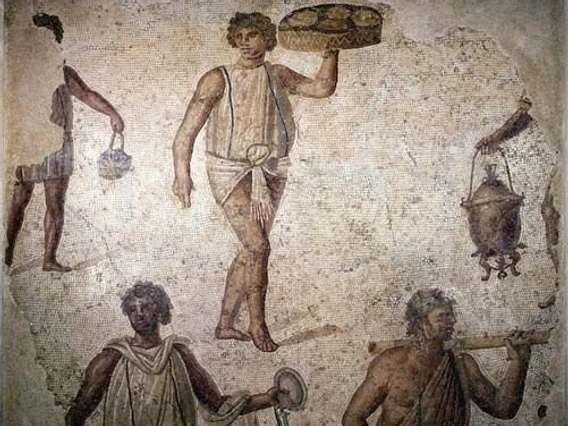
Shared public toilets were a common channel for spreading disease in Greek and Roman cities
It can be hard for citizens of modern Western nations to comprehend how vastly different health and sanitation practices were in Greek and Roman cities compared with our own and how these practices affected the health of their residents. All but the upper classes lived on the cutting edge of survival, and malnutrition was a constant threat, especially in periods of famine. Sanitation was poor, even in the larger cities that benefited from Roman sewers, and waste-born diseases were common. Public baths exposed bathers to all sorts of communicable diseases, and periodic floods spread germs across low-lying areas close to rivers. Those at the lower end of the socioeconomic spectrum lived in dirty, crowded quarters on the upper floors of tenement buildings or in dank cellars, while those at the very bottom slept in the open air on fetid sidewalks.
Contagious diseases spread rapidly under such conditions. At least half of all children died before reaching age 5, while the average age of death for those who survived into adulthood was around 40 for men and 35 for women, who faced the added threat of dying in childbirth.
Even the wealthy were not immune from the effects of sickness. Unlike modern cities where the rich live in their own neighborhoods segregated from the poor, people of all social levels lived closely together in Greek and Roman cities. Thus any disease that struck the poor was likely to affect the rich also unless they escaped to their farms in the neighboring countryside. The elites did enjoy healthier diets and had more ways of caring for their bodies than the poor, including regular exercise at the local gymnasium, and they could also afford the services of a physician when they needed one. If local treatments proved ineffectual, they could afford to travel to a regional treatment center seeking better care, as Lucius does in my novel, A Rooster for Asklepios.
Wealthy citizens who had good genes, healthy constitutions, and a lot of luck might have lived into their 60s or even 70s, but few would have reached their 80s, and most would have been seriously debilitated by then. Among the poor, it would have been unusual for children to grow up with living grandparents. Sickness and death were a constant feature of life for people at all social levels.
Medical historians have the grim task of determining what kinds of bodily ailments appeared most often in the Greco-Roman world. According to their studies, the most common problems were tuberculosis, malaria, rheumatic fever, cancerous tumors, gout, various infections and fevers, anemias, ophthalmia, bladder stones, and osteoarthritis. Fractures, dislocations, and other bodily injuries were also a normal part of life, especially among soldiers and farmers. Epilepsy is also mentioned often in the literature, but this is probably due to its unusual symptoms rather than its frequency.
A number of common modern diseases are unattested in the ancient records and may not have existed in the Greco-Roman world, including measles, chickenpox, rubella, scarlet fever, syphilis, gonorrhea, rheumatoid arthritis, and polio. Degenerative diseases also appear rarely due to the relative shortness of most people’s lives



